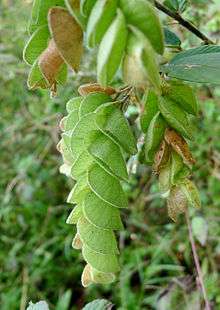Flemingia
| Flemingia | |
|---|---|
 | |
| Flemingia strobilifera | |
| Scientific classification | |
| Kingdom: | Plantae |
| (unranked): | Angiosperms |
| (unranked): | Eudicots |
| (unranked): | Rosids |
| Order: | Fabales |
| Family: | Fabaceae alt. Leguminosae |
| Subfamily: | Faboideae |
| Tribe: | Phaseoleae |
| Subtribe: | Cajaninae |
| Genus: | Flemingia Roxb. ex W. T. Aiton, 1812 |
| Species | |
|
See text. | |
Flemingia is a genus of flowering plants in the legume family Fabaceae. It is native to Asia and the species are distributed in Bhutan, Burma, China, India; Indonesia, Laos, Malaysia, Nepal, Pakistan, Papua New Guinea, Philippines, Sri Lanka, Taiwan, Thailand and Vietnam.[1][2] The genus was founded in 1812. The number of known species is ambiguous due to taxonomic problems; and is usually enumerated as more than 30. Burma and China have the highest record of Flemingia species with 16 each, followed by India (with 15 species), Thailand (11 species), Laos (10 species), Vietnam (8 species), Bhutan (1 species) and Nepal (5 species).[3]
Species of Flemingia are well known in traditional medicines in various Asian communities. This is attributed to their unique chemical properties, especially those of flavonoids and sterols. Most common medicinal applications are in the treatment of epilepsy, dysentery, stomach ache, insomnia, cataract, helminthiasis, rheumatism, ulcer and tuberculosis.[4]
Description
Members of Flemingia are shrubs, or herbs (or subshrubs); evergreen, or deciduous and perennial. They are generally about 0.2–1.5 m high. The stem is prostrate but weak. Leaves are small to medium-sized; not fasciculate, but alternate. The stem and leaves are pubescent, with dense hairs. Leaf blades are flat dorsoventrally. Flowers are aggregated in ‘inflorescences’; not crowded at the stem bases; in racemes, or in heads, or in panicles. Fruits are aerial, about 6–15 mm long; non-fleshy and hairy.[5][6][7]
Species
Some important species include:
- Flemingia bhutanica
- Flemingia brevipes
- Flemingia chappar
- Flemingia macrophylla
- Flemingia fruticulosa
- Flemingia rhodocarpa
- Flemingia grandiflora
- Flemingia lineata
- Flemingia philippinensis
- Flemingia prostrata
- Flemingia semialata
- Flemingia stricta
- Flemingia strobilifera
- Flemingia vestita
References
- ↑ Lewis G, Schrire B, MacKinder B, Lock M (2005). Legumes of the World. The Royal Botanic Gardens, Kew. p. 529. ISBN 1900347806.
- ↑ National Research Council (2002). Tropical Legumes: Resources for the Future. Books for Business/ The Minerva Group, Inc. pp. 37–38. ISBN 0894991922. External link in
|title=(help) - ↑ Mishra S (2001). "Revision of the genus Flemingia Roxb. ex. W.T. Aiton, nom.cons. (Leguminosae) in Nepal". Botanica Orientalis. 4 (1): 458.
- ↑ Ghalot K, Lal VK, Jha S (2011). "Phytochemical and pharmacological potential of Flemingia Roxb. ex W.T.Aiton (Fabaceae)". International Journal of Phytomedicine. 3 (3): 422–584. ISSN 0975-0185.
- ↑ Watson L (2008). Scientific Description: Flemingia W.T. Aiton. The Royal Botanic Gardens, Kew.
- ↑ Chaudhri AB (2005). Forests Plants of Eastern India. Ashish. pp. 205–206. ISBN 8170245370.
- ↑ Ren S, Gilbert MG (2010). "FLEMINGIA Roxburgh ex W. T. Aiton, Hort. Kew., ed. 2, 4: 349. 1812, nom. cons., not Roxburgh ex Rottler (1803)" (PDF). Flora of China. 10 (3): 232–237. ISSN 1043-4534.
External links
- Classification at Botanica Sistematica
- Plant Profile at USDA Plant Database
- ITIS Report
- Taxonomy at UniProt
- Classification at Encyclopedia of Life
- USDA GRIN Taxonomy for Plants
- NCBI Taxonomy Browser
- Plantillustrations